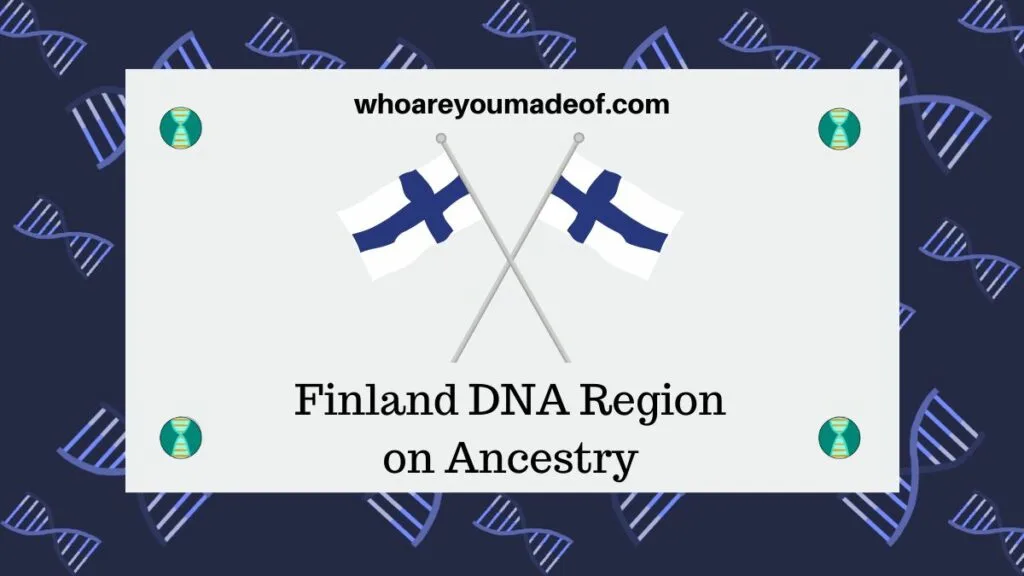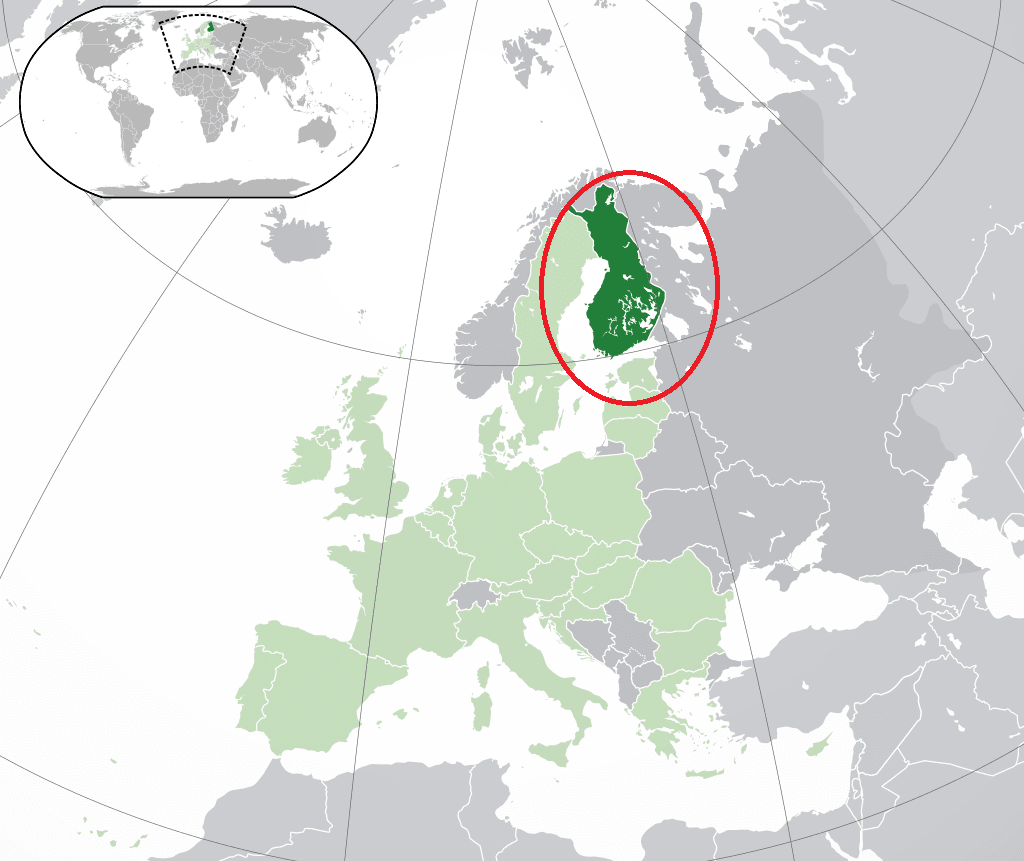Did you find out that you have Finland in your Ancestry DNA results? Are you wondering whether this means you have a recent ancestor from the area? You have come to the right place.
In this post, you’ll learn:
- Where the Finland DNA region is located
- Which countries have the Finland DNA ethnicity
- How far back you need to look in your family tree to find your Finnish ancestor
- Whether you can trace your Finland DNA to the ancestor you inherited it from

Where is the Finland DNA ethnicity region located?
The Finland DNA ethnicity region is located in Northern Europe, and includes Finland, which is adjacent to the northwest portion of Russia. People have been living in this part of the world for more than a hundred thousand years.
Languages spoken in this DNA region include the official languages in Finland of Finnish, Swedish, as well as Sami, Estonian, Russian, and Latvian.
In the image below, you can see the portion of Europe that includes this DNA ethnicity:

Where is the Finland DNA ethnicity found?
The Finland DNA ethnicity can be found all over the world, for reasons you’ll learn later on in this post, but is most commonly found in the country of Finland itself.
In addition, people who live in the following countries generally have at least some Finnish DNA in their Ancestry ethnicity estimate:
- Estonia
- Sweden
- Latvia
- Lithuania
If you don’t have known ancestors from this region, you are probably wondering how in the world you ended up with Finnish DNA. Below, I’ll discuss what it might mean to have this ethnicity in your DNA results, and how you might have inherited it.
What does it mean to have Finland DNA?

If If you have more than just a few percent Finland DNA on your DNA results, there is a good chance that you had an ancestors, or many ancestors, who lived in the area that makes up Finland.
If your percentage is very small (less than 1-2%), then there is a strong possibility that you had ancestors from this region.
People who are native to the Finland region tend to be less admixed (sharing little to no DNA with neighboring regions – the average native to this region has about 99% Finland DNA), which could mean that a test is less likely to mistake DNA from another region for Finland.
Basically, if you have this DNA region on your results, you probably have an ancestor who lived there, though it could have been several generations ago.
Where else can you commonly find Finnish DNA?
It’s most common to find Finland DNA in nearby region. For example:
- 25% of people in Scandinavia will show at least some DNA from Finland
- 10% of Eastern Europeans will show DNA from this region
- 5% of Western Europeans will show DNA from this region
- 3% of people in Great Britain will show DNA from this region

When you are thinking about your ethnicity results in terms of how to trace that ethnicity, or find the ancestor who might have passed that ethnicity down to you, it is important to know that it’s possible that the ethnicity came to you through an ancestor from a third DNA region, like one of the areas listed above – which is also not a comprehensive list.
How did Finland DNA get in your results?
For centuries, Finland was dominated by foreign powers. First it was the Swedish, who ruled Finland for about 600 years until a war between Sweden and Russia brought their domination in Finland to an end.
Finland became a relatively autonomous part of Russia, and was called the Grand Duchy of Finland from 1809-1917.

More than 1 million people left Finland between 1860-1996. More than half of them went to Sweden, which is important to know. If you have Swedish ancestors, it’s entire possible that your Finland DNA arrived through an immigrant from Finland to Sweden.
Other popular places for Finnish migrants during the 130 years after 1860:
- United States received about 315,000 Finnish immigrants
- Canada received about 90,000 Finnish immigrants
- Oceania (including Australia and New Zealand) received more than 20,000 Finnish immigrants
- Asia and Africa received more than 5,000 Finnish immigrants each
- Latin America, including Mexico, received several thousand Finnish immigrants
Even though most Finnish immigrants came to the United States during the later half of the 19th century, it’s important to know that people did come from Finland to North America prior to those years. The exact number of Finnish people who came to America before 1860 is unknown, but there were at least several hundred Finns living in what would become the United States as early as the 1600s.
Is it possible to trace Finnish DNA?
If your Finland DNA came into your family line within the past 200 years, you have an excellent chance of being able to trace it. Depending on your unique family circumstances, your family’s religion, where they have lived over the past several generations, and how diligent they were at keeping records, it could be easy – or you might have to spend some time on your research.
The first step in tracing your Finland DNA is to put together a basic family tree, if you don’t already have one. I recommend starting by interviewing your parents, grandparents, and other older relatives and learning as much as you can of the family stories about where your ancestors traveled from, languages they spoke, and religions that they practiced.
- Learn how to conduct a cultural heritage interview to learn more about your Finland DNA and Finnish ancestry
It is important to know that while surnames had been used in Finland for centuries, they were not required until around 1921. Prior to this time, many people in Finland used the surnames of the farm where they worked, which means that not everyone with the same surname will have a genealogical connection.
Furthermore, when someone moved to work at a different farm in another location, they may have even changed their name. This means that documents and records could have a different surname for the same person.
To keep all of my family tree records organized, I use Ancestry. It’s free to build a tree and upload photos and documents, and you can always access your tree (and share it with family, too!).
The reason that I like Ancestry is because I can connect it with my DNA results to unlock some really neat features, and I can also access lots of documents and other public family trees that help me learn more about where my ancestors lived.
In order to access documents and family trees, you’ll need to have a subscription. If you use the following link, you can get a two-week free trial. If you end up subscribing at the end of your free trial, I may receive a very small commission at no extra cost to you – so thank you for using this link to get your free trial:
Here are some tips for building your tree back to your Finnish ancestor, using the basic family tree you have already built, and your DNA results:
- Locate your ancestors on each US Federal Census to figure out where you should look for immigration and travel records
- Once you figure out where your ancestors came from, start researching where you can find online records in that country – the HisKi project run by the Genealogical Society of Finland is a great place to start
- Starting with your closest DNA match, determine how they are related to you
- Work through as many of your DNA matches as you can, making sure to spend time trying to figure out your connection
- Upload your DNA file to other places, like My Heritage DNA, Family Tree DNA, or Gedmatch, in order to get DNA matches
- Use a site like DNA Painter to “paint” your matches and figure out which DNA segments you inherited from which ancestors
What if you don’t know how you got Finland in your DNA results?
Many people might be surprised to see the Finland DNA region in their Ancestry ethnicity estimate. In fact, we had this happen in my own family.
My grandmother has Finland on her Ancestry DNA results, and we have no known Finnish ancestors. However, my grandmother also received a few other unexpected regions in her results, including 11% Sweden and Denmark and 2% Norway.
The geographic proximity of these unexpected regions, as well as careful examination of her DNA matches, have led me to suspect that we have a non-paternity event (NPE) in our family tree. In other words, there is an error in my grandmother’s known family tree.
You can use the additional regions that have shown up in your results in order to develop theories about how you may have inherited your DNA matching the Finland region. In my grandmother’s tree, I am working on the theory that her unknown ancestor was likely from Sweden or Denmark, and that this ancestor may have had more distant ancestry from Finland and Norway.
What happened to the Finland/Northwest Russian DNA Region?
For a period of a few years, the Finland DNA region was known as the “Finland/Northwest Russia” DNA region on Ancestry. However, as the science behind ethnicity and ancestry testing has improved, they have been able to further isolate Finnish ancestry and it now has its own region.
People with Russian ancestry are more likely to see DNA from some one of the Russians in Eastern Europe communities. However, if your Russian ancestors lived in a region near the Finnish border with Russia, you might see Finland DNA in your Ancestry results.
Conclusion
I hope that this post has helped you understand a little bit about the Finland DNA ethnicity, how you might have inherited it, and how to go about beginning to trace your Finnish roots.
If you have any questions about something that you read here, or would like to share your own experience finding this DNA ethnicity in your results, I would love to hear from you in the comments.
Thanks for stopping by!
